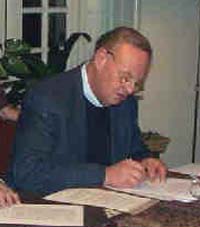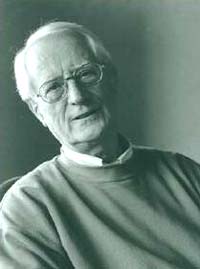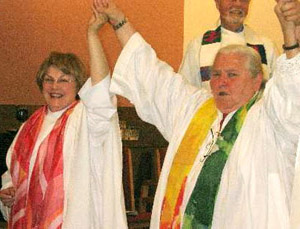 |
NEWS: October 1, 2007
Bird’s Eye View of the News
Atila Sinke Guimarães
MASS SAID BY LAYMEN - We have two interesting releases of religious news recently coming from the Netherlands.
First, it was reported that the Dutch Catholic Church is envisaging closing a number of seminaries and parishes since religious life has lost its appeal for young men, and the assistance of the faithful at the Mass-Sacraments continues to drop. These inevitable effects of the reforms of Vatican II, which alleged that it was adapting to the modern world to bring more people to the Church, can be seen everywhere. But in the Netherlands the figures are particularly expressive. The seven Catholic Dioceses in the country possess seven seminaries, which all together have less than 100 students today. This teaching structure produces just 12 to 15 priests a year, far less than the necessary.




From the top, Frs. André Lascaris, Jan Nieuwenhuis, Harrie Salemans and Ad Willems |
Msgr. Matthieu Ham, the rector of a Dutch seminary until he was removed from his post last August, suggested a radical restructuring in the system of Catholic teaching in the Netherlands. In an interview with the weekly Katholiek Niewsblad, he affirmed that the present day structure in seminaries is unsustainable because “it costs money, people and energy. You have lecturers who rattle off the same presentation two or three times for only two students.” He emphasized that “it is laughable that we have seven institutes for not even 100 students.” Msgr. Ham thinks that the number of seminaries should be reduced to three, one normal full-time seminary, and two others for half-time students – one for those who want to follow a seminary course while studying at a university, and another for men with late vocation who have jobs.
The number of parishes is rapidly downsizing as well. From 1,600 parishes in 2000, there are less than 1,400 today. Kashi, a Church research institution in Nijmegen, estimates that this total will drop to 600 in the next 10 years (The Tablet, August 4, 2007. p. 31). Catholicism is still the single largest religion of the Netherlands. However, although 27 % of the Dutch people call themselves Catholic, only 8 % say they go to Mass regularly (University of Nijmegen Institute for Ecclesiastical Statistics website).
This news paves the way for the second news report, which is much more explosive. Four Dominican theologians, with the due approval of their superiors, launched a small book (38 pages) titled Church and Ministry. In it, they defend that lay ministers chosen by their congregations should be allowed to celebrate Mass if no ordained priest is available. It also advocates that the Catholic Church should drop her priest-centered ecclesiology in favor of one developed around a community sharing bread and wine in prayer.
Using the early Church as its model, the Dominicans maintain that the congregation could choose its own lay minister to lead services. The minister and the congregation would speak the words of the consecration together. “Speaking these words is not the exclusive right or power of the priest; it is the conscious expression of faith by the whole congregation,” the work affirms.
“Whether they are women or men, homosexual or heterosexual, married or single, makes no difference. What is important is a communicative attitude of faith,” it continues.
The authors are Dominican Frs. André Lascaris, Jan Nieuwenhuis, Harrie Salemans and Ad Willems, known theologians of Nijmegen and Amsterdam.
The work was sent in the mail to all the parishes in the country, and is causing considerable turmoil. The Dutch Episcopate issued a note saying that the booklet “is in conflict with the faith of the Roman Catholic Church” (The Tablet, September 8, 2007, p. 29).
There is no doubt the Bishops are right. This model is equivalent to that of the Anabaptist Protestant sect. No more priests, the ministers are just representatives of the faithful. Notwithstanding, the initiative of these Dutch theologians establishes a model, raises a banner, and reveals the direction Progressivism wants to take the Church next. Many people will be horrified by this, which is a good reaction. What they don’t realize, however, is that this is just the last step of a whole process that has been implemented everywhere for more than 40 years by the Bishops themselves, and even the very Vatican.
Indeed, the first step of this egalitarian process was to promote collegiality of the Bishops to the detriment of the power of the Pope. Then, the autonomy of priests as a liberation from the command of the Bishops was encouraged. Now the next step seems inevitable: equality between lay people and the priest, either regarding the power of jurisdiction or the power of orders.
A serious reaction against the final step must consider the whole revolutionary process and, therefore, reaffirm the monarchical nature of the Church around the Papacy, and reinforce hierarchy at all levels. Any solution that does not plumb this depth of the principles is a superfluous effort that sooner or later will lead to a total democratization of the Church.
WOMEN PRIESTS AND THE END OF CELIBACY – An open-letter to Benedict XVI by 110 Brazilian laymen was posted September 28 online asking for changes in the structure of the Catholic priesthood. Alleging that they lack an open door to debate their concerns with the Church Hierarchy, which incidentally is not objective as shown elsewhere, the group wrote directly to the Pope.

In Canada five women and a married men were "ordained" priests
|
According to the signers, since Brazil has the lowest ratio of priest per parishioners, one priest for each 10,000 Catholics, more priests are desperately needed. Because the youth are not responding to appeals to enter the seminaries, they suggest a debate be opened in the Church on the topic of changing the priesthood.
Jumping ahead to the conclusions of such debate, they propose the Pope take two measures:
- Allow married priests and readmit the priests who left the ministry to marry. Only in Brazil, the latter would number 5,000.
- Create a female priesthood that permits both single and married women to become priests.
We recognize these demands; they repeat the same old song of We Are Church. What is new in the picture is the emphasis such demands are acquiring throughout the Church. More and more people are clamoring against celibacy for the clergy. If the Vatican and the Hierarchy do not take strong measures to put a stop to this opposition, this institution will not resist for much longer.


Related Topics of Interest
 Women Priests - The Process Started Women Priests - The Process Started
 Much Thunder and no Rain Much Thunder and no Rain
 A Dutch Priestess in the Making A Dutch Priestess in the Making
 Madame the Bishop, Lady Priests Madame the Bishop, Lady Priests
 Married priests? They are Here Married priests? They are Here
 Card. Ratzinger on Feminism Card. Ratzinger on Feminism
 John Paul II and Women in the Altar John Paul II and Women in the Altar
 The Eternal Feminine The Eternal Feminine


|
News | Home | Books | CDs | Search | Contact Us | Donate

©2002- Tradition in Action, Inc. All Rights Reserved
|
 |
|